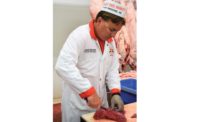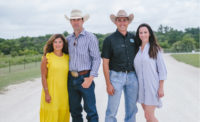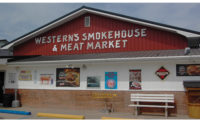Many of the most recent innovations in burgers today have come in the size of the patty or the type of cuts used in the grind. The packaging of the product, though, has stayed largely the same. Consumer demographics show that a big box of frozen patties may not fit the needs of every family. To that end, Jensen Meat has done what it has always done in its history: utilize its expertise, experience, and technology to create a product that fills in a niche in the marketplace.
Jensen Meat, a San Diego, Calif.-based grinding specialist, has a history that goes back more than 60 years. However, it has worked under-the-radar for much of that time, working with private-label customers. A change in ownership, a new operating philosophy, and a new processing facility have led to record sales and exciting partnerships. Jensen’s latest venture, a line of frozen, packaged single burger patties under the Solos brand, brings a variety of burger options to the customer, whether they’re meat-eaters, flexitarians or vegetarians.
Abel Olivera, Jensen’s Chief Executive Officer, has been with the company since 2005. He was hired by Bob Jensen, the company’s longtime former owner who retired in 2011. When the company was acquired by Jeff & Gregg Hamann., Olivera took on the role of chief operating officer and eventually was named CEO. He had experience in other industries before entering the meat industry, and he set about developing a new corporate culture.
“We already had a really great team in place. I just took the lid off each one and gave them that freedom to run their departments to the best of their expertise and knowledge,” he explains.
Olivera believes that employees should have the freedom to do their job without constant oversight.
“If I'm going to my boss and trying to get my boss to tell me every decision I need to make, then I'm not doing my job,” he states. “The same way that I've worked with my bosses is the same way that I want my people to work with me.
“We have a VP of production that's been with our company for 30-plus years,” he continues. “He has more experience than me in the plant. Why am I going to be telling him what to do? If there is a problem, I expect him to say to me, ‘Abel, this is what we're going to do, and this is why.’”
Jensen’s team has long been one of its greatest strengths and helped give it a reputation as a premier grinder. For all its success, the Jensen Meat name was not widely known. As Olivera worked to open up the company from an internal perspective, he also worked to raise Jensen’s visibility in the meat industry and its community.
Where the company was once a co-packer only, Jensen-branded products now comprise 20 percent of the company’s products. That number is steadily growing. In recent years, Jensen has developed an array of exciting new products through collaborations with partners like Certified Angus Beef, Bo Jackson and his business VEJ Holdings, and restaurant chain Slater’s 50/50.
“We're definitely proud to work with these legendary brands,” Olivera says. “I think the one thing that enables us to partner with these companies is our flexibility. The people behind the brands see that energy behind our brand, and they want to partner with us.”
Jensen’s flexibility has extended into the plant-based protein market as well. Two years ago, the company started producing plant-based burgers for Before the Butcher, a fast-rising name in the plant-based protein niche. Earlier this summer, Hamann Cos. acquired the brand, ensuring a long-term co-packing agreement for Jensen.
Olivera says that he attended an industry conference several years ago that discussed how the plant-based protein market could encroach upon the meat space in the supermarket. Olivera took a different viewpoint.
“Ultimately, the customer is going to buy what they want. If the customer wants healthier choices, and if we don't give it to them, they're going to buy someplace else,” he explains. “So, either we could be against them, or we could find a way of engaging in that sector and giving our customer base the flexibility and options they want."
Through its work with Before the Butcher, Jensen has perfected the craft of making tasty plant-based burgers, just like it did with beef burgers. The patties are formulated for beef, pork, or chicken flavors. Not only are they designed to appeal to the vegetarian market, but they are also meant for meat-eaters who for one reason or another are looking to add more plant-based protein to their diet.
“We're not in the business to sell and make a profit; we're in the business to feed the world, ultimately. And the population growth is outpacing the cattle growth, so we still have to continue diversifying and finding new food options to be able to meet that population growth,” Olivera says.
The company’s capabilities at producing plant-based burgers is allowing it to bring its Solos burgers to market with a wide variety of options for any type of consumer. Jensen is launching the concept with 12 types of burger patties, from plant-based to its traditional beef patty to a beef/mushroom blend. The idea is to allow consumers to get exactly the burger they want in the exact quantity they want.
Olivera says, “The last census shows that over 40 percent of U.S. households are either singles or couples. They're not going to be buying in bulk anymore. They want to buy for individual meals.”
Solos will be targeted toward single or married consumers with small households, so target consumers include Baby Boomers whose children have moved out of the house, single or married Millennials with no children or Gen Z young adults who are starting to live on their own. The Solos concept works for families as well, as not everyone in a family eats the same thing. This way, shoppers can go to one section of the meat case, pick up a couple of plant-based burgers for the vegetarians, a jalapeno-cheese burger for those who like a little kick, and a beef/bacon blend or traditional patty for others. Most importantly, at the end of the meal, a consumer isn’t left with multiple boxes of open frozen burger patties filling up their freezer.
Olivera says that the first retailer that Jensen approached with Solos turned down the idea. The Jensen sales team explained that if the retailer was so concerned about sustainability, why would it stock only bulk boxes of frozen burger patties, knowing that many of those patties will sit in a freezer before being discarded? It did not take long for the retailer to reverse its decision and will be an early carrier of the product.
“Sometimes, it does take a little bit of convincing, and it's just showing them the data. The data is there. The data shows that people will buy a single unit patty,” Olivera explains. “Why hasn't anyone done it? I don't know, but I feel there is a huge opportunity for single pack patties out there in the market right now.”
The Solos patties will initially launch in a raw, frozen format. There is plenty of room to grow the brand, including frozen pre-cooked varieties.
Reinventing Jensen Meat
Olivera credits Bob Jensen with giving him the autonomy to seek out ways to grow the business. That experience has helped to mold his business philosophy as CEO.
“When you have a mentor that believes in you and teaches you everything they know, you're then able to stand on the shoulders of everything they've accomplished and take all that generously shared knowledge to become the best version of what you can be as a team leader,” he says.
When Olivera was initially brought into the company to oversee production, Jensen Meat was already successful but had a couple of constraints. First and foremost was the fact that the company’s 20,000 square foot facility was at capacity. It was running seven days a week, and it was impossible to squeeze one more patty out of the building.
Olivera created a five-year business plan that showed the potential the company had if it could move into a larger facility. Bob Jensen at the time was nearing retirement age and began the process of selling the company. Olivera spoke with general contractors, and one of them happened to be interested in acquiring the business. Hamann Construction owners Jeff & Gregg Hamann. saw the potential that Jensen had and, in 2011, acquired the business and moved it to a larger location in 2013.
The new building is one of the most modern plants west of the Mississippi River, with a custom-designed fully automated and computer-controlled state-of-the-art grinding line system. As a nice bonus, Jensen’s parent company owns a cold storage building right next to the plant.
Jensen operates out of a 150,000-square-foot building, though some of that is currently used by other tenants. It uses about 81,000 square feet of space and has reconfigured that space multiple times already to maximize its production capabilities. It started with 4 IQF lines and two fresh lines and added two more IQF lines in 2017. A new expansion will add two more IQF lines and reconfigure the fresh production lines. When completed, it will add approximately 30 million pounds of frozen burger capacity and 10 million pounds of fresh beef capacity. There is also a 16,500-square-foot room for Beyond the Butcher products.
The goal when Jensen opened the new facility was to reach a yearly production of 100 million pounds within 10 years. It is set to achieve that goal this year, four years ahead of schedule.
While a new plant and technological innovation are great, the real source of Jensen’s growth has been in its team members. It has about 300 full-time employees and 180 part-time workers, and many of them have been with the company for years. Existing employees regularly bring their siblings or children into the business. Veteran leadership help sets the tone. Mundo Garcia, the production manager, has been with the company for 43 years; he remembers when the company used to produce about 100 pounds of ground beef per week. Anthony Crivello, vice president of manufacturing, has been with the company for 32 years. Trisha Lavigna has held many positions in her 20-plus years with the company. She currently is the vice president of executive accounts, overseeing sales, marketing & customer service.
When gathered together, the management team teases each other, compliments each other and sometimes finishes each other’s sentences. When asked to sum up their relationships, they all agree that it’s like a family.
“We really have each other's backs, every day. It's really cool. Him and I have sat across from each other for over 23 years,” Crivello says, gesturing to Jeff Duran, vice president of logistics.
“I see him more than…” Duran says before Crivello finishes with “our spouses.”
“He’s like my brother,” Duran adds.
Debbie Dardon, quality assurance manager, had been with the company for seven years before leaving. She came back six months ago after a seven-year absence. “I had quite a few jobs in the seven years, and I never worked with a management team like this group here. Like Anthony said, we have each other's back. I did not see that anywhere else, so that's why I'm back.”
The management team was intimately involved in the design of the plant, with everyone having a chance to add what they wanted. Those requests, from a larger raw materials storage area to more truck docks, helped to make the plant more functional, and it also gave the employees a sense of ownership in the new facility.
The success that the company has enjoyed in recent years puts it in rarefied air in the meat industry. It has enjoyed double-digit growth since 2018. With its success, Jensen Meat has worked hard to give back to the communities of San Diego and Tijuana, Mexico. Jensen’s plant is mere blocks from the U.S.-Mexico border, and the company donates hamburgers and organizes toy drives for communities in need on both sides of the border.
“Since we have a lot of employees that cross the border daily who work for us, we feel that we also need to give back to that community. So we partner with a charitable house called Casa de los Pobres,” Olivera says.
Jensen’s modern operations and its trendy new Solos burgers have the company on the cutting edge of the meat industry. Olivera and the company’s management remain humble and grounded about its strong growth, though. The products and the process are definitely noteworthy, but the employees and the sense of community that has developed at Jensen are what has kept the company running strong for more than 60 years.
We have a nice looking brand, but without the people that are supporting it behind it, it will be worthless,” Olivera says.
Visit www.provisioneronline.com for more information about Jensen Meat, including its facility, how it finds employees, and valuable Jensen Bucks.









Report Abusive Comment